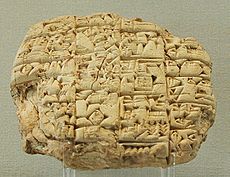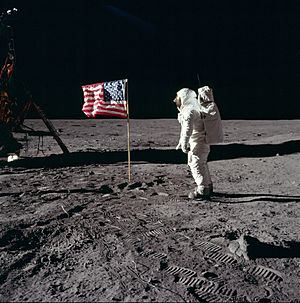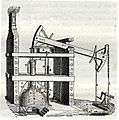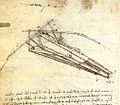History of technology facts for kids
The history of technology is the history of the invention of tools and techniques, and is similar in many ways to the history of humanity.
People make new things and, conversely, many scientific endeavors are possible through technologies. Technology lets us travel to places we could not otherwise go, and probe the nature of the universe in more detail than our natural senses allow.
Technological artifacts are products of an economy, a force for economic growth, and a large part of everyday life. Technological innovations affect, and are affected by, a society's cultural traditions. They also are a means to develop and project military power.
What are the great technologies?
- The hand axe: used for about 1.5 million years, from Homo erectus to neolithic man. Basically a tool for butchering large animals which were probably killed by wooden spears. Not for nothing did a curator at the British Museum use the phrase Man the Toolmaker.
- Fire, which would have occurred naturally in the drier environments of the savannah. The date of the first deliberate use of fire for warmth, protection and cooking is not known.
- The city: we can date this to about 8000 years ago in the fertile crescent.
- Writing: the means of trade, education and cultural transmission from one generation to another. About 3300 BC.
Contents
Early technology by time period and geography
The following is a summary of the history of technology by time period and geography:
- Olduvai stone technology (Oldowan) 2.5 million years ago (scrapers; to butcher dead animals)
- Acheulean stone technology 1.6 million years ago (hand axe)
- Fire creation and manipulation, used since the Paleolithic, possibly by Homo erectus as early as 1.5 Million years ago
- (Homo sapiens - modern human anatomy arises, around 200,000 years ago.)
- Clothing possibly 170,000 years ago.
- Stone tools, used by Homo floresiensis, possibly 100,000 years ago.
- Ceramics c. 25,000 BC
- Domestication of animals, c. 15,000 BC
- Bow, sling c. 9th millennium BC
- Microliths c. 9th millennium BC
- 6000 BCE Handmade bricks first used for construction in the Middle East
- Agriculture and Plough c. 4000 BC
- Wheel c. 4000 BC
- Gnomon c. 4000 BC
- Writing systems c. 3500 BC
- Copper c. 3000 BC
- Bronze c. 2500 BC
- Salt c. 2500 BC
- Chariot c. 2000 BC
- Iron c. 1500 BC
- Sundial c. 800 BC
- Glass ca. 500 BC
- Catapult c. 400 BC
- Horseshoe c. 300 BC
- Stirrup first few centuries AD
20th century
20th century technology developed rapidly. Broad teaching and implementation of the scientific method, and increased research spending contributed to the advancement of modern science and technology. New technology improved communication and transport, thus spreading technical understanding.
Mass production brought automobiles and other high-tech goods to masses of consumers. Military research and development sped advances including electronic computing and jet engines. Radio and telephony improved greatly and spread to larger populations of users, though near-universal access would not be possible until mobile phones became affordable to developing world residents in the late 2000s and early 2010s.
Energy and engine technology improvements included nuclear power, developed after the Manhattan project which heralded the new Atomic Age. Rocket development led to long range missiles and the first space age that lasted from the 1950s with the launch of Sputnik to the mid-1980s.
Electrification spread rapidly in the 20th century. At the beginning of the century electric power was for the most part only available to wealthy people in a few major cities such as New York, London, Paris, and Newcastle upon Tyne, but by the time the World Wide Web was invented in 1990 an estimated 62 percent of homes worldwide had electric power, including about a third of households in the rural developing world.
Electron microscopes were very powerful by the late 1970s and genetic theory and knowledge were expanding, leading to developments in genetic engineering.
The first "test tube baby" Louise Brown was born in 1978, which led to the first successful gestational surrogacy pregnancy in 1985 and the first pregnancy by ICSI in 1991, which is the implanting of a single sperm into an egg.
The massive data analysis resources necessary for running transatlantic research programs such as the Human Genome Project and the Large Electron-Positron Collider led to a necessity for distributed communications, causing Internet protocols to be more widely adopted by researchers and also creating a justification for Tim Berners-Lee to create the World Wide Web.
Vaccination spread rapidly to the developing world from the 1980s onward due to many successful humanitarian initiatives, greatly reducing childhood mortality in many poor countries with limited medical resources.
The US National Academy of Engineering, by expert vote, established the following ranking of the most important technological developments of the 20th century:
- Electrification
- Automobile
- Airplane
- Water supply and Distribution
- Electronics
- Radio and Television
- Mechanized agriculture
- Computers
- Telephone
- Air Conditioning and Refrigeration
- Highways
- Spacecraft
- Internet
- Imaging technology
- Household appliances
- Health technology
- Petroleum and Petrochemical technologies
- Laser and Fiber Optics
- Nuclear technology
- Materials science
21st century
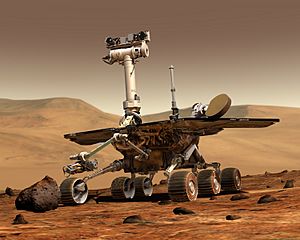
In the early 21st century research is ongoing into quantum computers, gene therapy (introduced 1990), 3D printing (introduced 1981), nanotechnology (introduced 1985), bioengineering/biotechnology, nuclear technology, advanced materials (e.g., graphene), the scramjet and drones (along with railguns and high-energy laser beams for military uses), superconductivity, the memristor, and green technologies such as alternative fuels (e.g., fuel cells, self-driving electric and plug-in hybrid cars), augmented reality devices and wearable electronics, artificial intelligence, and more efficient and powerful LEDs, solar cells, integrated circuits, wireless power devices, engines, and batteries.
Perhaps the greatest research tool built in the 21st century is the Large Hadron Collider, the largest single machine ever built. The understanding of particle physics is expected to expand with better instruments including larger particle accelerators such as the LHC and better neutrino detectors. Dark matter is sought via underground detectors and observatories like LIGO have started to detect gravitational waves.
Genetic engineering technology continues to improve, and the importance of epigenetics on development and inheritance has also become increasingly recognized.
New spaceflight technology and spacecraft are also being developed, like the Orion and Dragon. New, more capable space telescopes, such as the James Webb Telescope, to be launched to orbit in late 2018, and the Colossus Telescope are being designed. The International Space Station was completed in the 2000s, and NASA and ESA plan a manned mission to Mars in the 2030s. The Variable Specific Impulse Magnetoplasma Rocket (VASIMR) is an electro-magnetic thruster for spacecraft propulsion and is expected to be tested in 2015.
Breakthrough Initiatives, together with famed physicist Stephen Hawking, plan to send the first ever spacecraft to visit another star, which will consist of numerous super-light chips driven by Electric propulsion in the 2030s, and receive images of the Proxima Centauri system, along with, possibly, the potentially habitable planet Proxima Centauri b, by midcentury.
2004 saw the first manned commercial spaceflight when Mike Melvill crossed the boundary of space on June 21, 2004.
Images for kids
-
A variety of stone tools
-
Pont du Gard in France, a Roman aqueduct
-
Clock from Salisbury Cathedral ca. 1386
-
Dome of Florence Cathedral
-
Design for a flying machine (c.1488) by da Vinci
See also
 In Spanish: Historia de la tecnología para niños
In Spanish: Historia de la tecnología para niños



